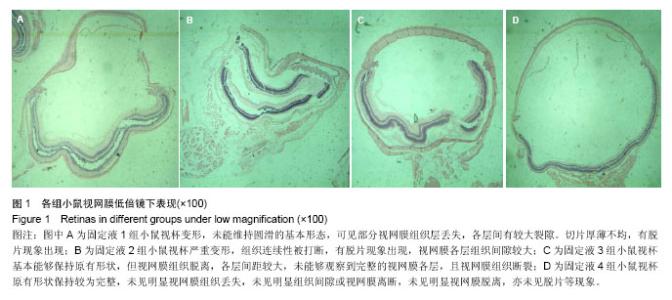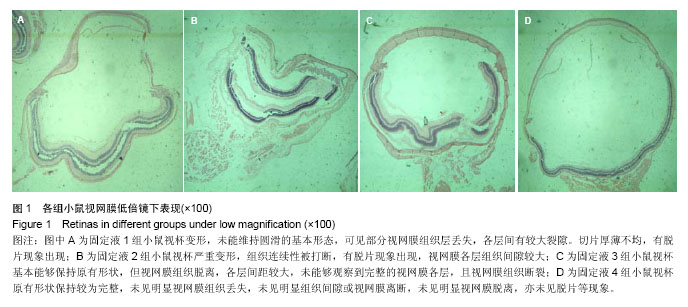Chinese Journal of Tissue Engineering Research ›› 2014, Vol. 18 ›› Issue (24): 3791-3796.doi: 10.3969/j.issn.2095-4344.2014.24.004
Previous Articles Next Articles
Fixation effects of four different complex fixatives on mouse retina
Pei Xi1, Wu Qiu-ping2, Ke Xiao-yun1, Peng Yan-yang1, Chen Xiao-hong1
- 1Department of Ophthalmology, Zhujiang Hospital of Southern Medical University, Guangzhou 510280, Guangdong Province, China
2Department of Pediatrics, Zhujiang Hospital of Southern Medical University, Guangzhou 510280, Guangdong Province, China
-
Revised:2014-04-18Online:2014-06-11Published:2014-06-11 -
Contact:Ke Xiao-yun, Chief physician, Master’s supervisor, Department of Ophthalmology, Zhujiang Hospital of Southern Medical University, Guangzhou 510280, Guangdong Province, China -
About author:Pei Xi, Studying for master’s degree, Department of Ophthalmology, Zhujiang Hospital of Southern Medical University, Guangzhou 510280, Guangdong Province, China Wu Qiu-ping, Studying for master’s degree, Department of Pediatrics, Zhujiang Hospital of Southern Medical University, Guangzhou 510280, Guangdong Province, China Pei Xi and Wu Qiu-ping contributed equally to this work. -
Supported by:a grant from Science and Technology Plan of Guangdong Province, No. 2011B031800105
CLC Number:
Cite this article
Pei Xi, Wu Qiu-ping, Ke Xiao-yun, Peng Yan-yang, Chen Xiao-hong . Fixation effects of four different complex fixatives on mouse retina[J]. Chinese Journal of Tissue Engineering Research, 2014, 18(24): 3791-3796.
share this article
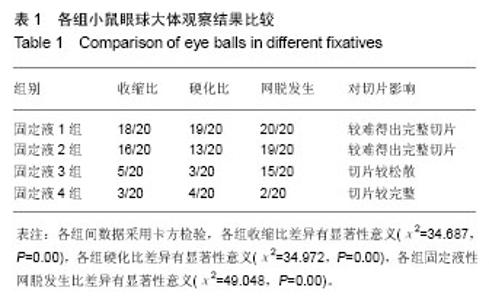
2.1 大体观察 固定脱水后肉眼可见固定液1组、固定液2组小鼠眼球部分视杯凹陷皱缩,不能保持原有形态;固定液3组、固定液4组小鼠眼球外形圆滑,色泽亮白透明,眼杯形状未见明显皱缩凹陷等变形,眼球形状基本保持原有状态。 切片时固定液3组、固定液4组小鼠眼球手感适中,易得出较完整视网膜切片,而固定液1组、固定液2组小鼠眼球切片均出现不同程度皱缩变形(表1)。 固定液1组小鼠视杯变形,未能维持圆滑的基本形态,可见部分视网膜组织层丢失,各层间有较大裂隙。切片厚薄不均,有脱片现象出现(图1A)。 固定液2组小鼠视杯严重变形,组织连续性被打断,有脱片现象出现,视网膜各层组织间隙较大(图1B)。 固定液3组小鼠视杯基本能够保持原有形状,但视网膜组织脱离,各层间距较大,未能够观察到完整的视网膜各层,且视网膜组织断裂(图1C)。 固定液4组小鼠视杯原有形状保持较为完整,未见明显视网膜组织丢失,未见明显组织间隙或视网膜离断,未见明显视网膜脱离,亦未见脱片等现象(图1D)。"
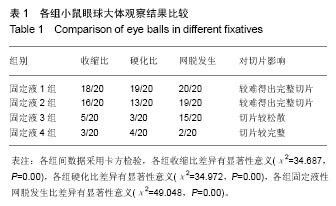
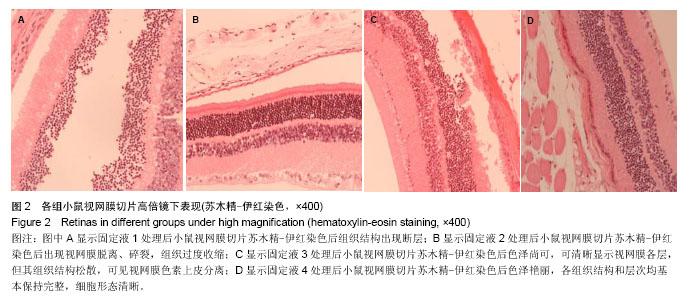
2.2 苏木精-伊红染色 固定液1组小鼠视网膜各层组织均有不同程度断裂,部分组织结构缺失,视网膜各层组织间隙较大。组织细胞结构疏松,细胞着色亮丽,染色质均匀,细胞核清晰,各层颜色对比明显(图2A)。 固定液2组小鼠视网膜各层分离,组织断裂,组织缺失。视网膜各层组织结构间存在裂隙。组织细胞间龟裂变形,组织间隙增大,细胞收缩,着色加深,细胞内组织结构颜色对比不明显(图2B)。 固定液3组小鼠视网膜各层组织结构较清晰,色泽可,各层组织结构完整,细胞结构较清晰,但可见固定液性视网膜分离(图2C)。 固定液4组小鼠视网膜各层组织结构完整,无明显结构改变,未见视网膜的脱落和分离,眼球各层组织结构清晰无裂隙。组织细胞间无龟裂变形,无细胞过度收缩和膨胀,未见组织的自溶;细胞核仁、核膜清晰,染色质均匀,色泽亮丽,颜色对比明显(图2D)。"
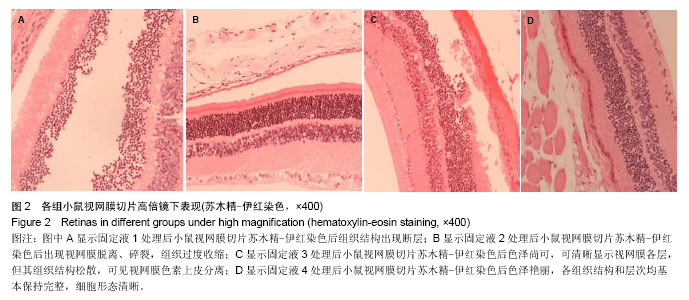
| [1] 曾玉晓,陈丽峰,刘康,等.RCS大鼠眼球冰冻切片前固定的方法[J].第三军医大学学报,2011,33(19):2096-2097. [2] 张文忻,李永平,林健贤,等.冰醋酸固定液对视网膜组织固定效果的探讨[J].眼科学报,2006,22(2):112-114. [3] 常永杰,马长路.冰冻切片法制作豚鼠眼球切片[J].中原医刊, 2006, 33(8): 29-30. [4] 王春霞,于紫燕,张劲松.大鼠视网膜标本石蜡切片的固定方法[J].解剖学研究, 2012,34(4):316-318. [5] 胡宏慧,曹晖.大鼠眼球标本石蜡制片方法的探讨[J]. 眼科新进展, 2001,21(6): 403. [6] 常永杰,马长路.人眼球冰冻切片制作实验研究[J]. 中国实用眼科杂志, 2006,24(10):1095-1096. [7] 李晶晶,朱鸿,施彩虹. 三种方法对大鼠视网膜固定效果的比较研究[J]. 上海交通大学学报:医学版, 2011,31(8):1105-1107. [8] 刘桂明,刘向云,谢琛静,等.三种固定液对眼球组织固定效果的比较研究[J].实验动物与比较医学,2009,29(1):57-59. [9] 王翠菊,孙晓冬,李静.石蜡包埋眼球大切片的制作方法与改进[J].诊断病理学杂志, 2007,14(4): 313. [10] 张祥令,苏敏,黄悦,等.石蜡包埋制作猫眼球切片方法的改良[J].第三军医大学学报,2011,33(15):1649-1650. [11] 谢玲,张志平,林坚涛,等.小鱼眼球视网膜组织石蜡切片的制作方法[J].广东医学院学报,2007,25(5):595-596. [12] 杨明,唐永赢,周媛,等.一种优化的大鼠视网膜组织石蜡切片制作方法[J].昆明医科大学学报,2013,34(12):5-8. [13] Regadera J, Martínez-García F, González-Peramato P,et al.Androgen receptor expression in sertoli cells as a function of seminiferous tubule maturation in the human cryptorchid testis.J Clin Endocrinol Metab. 2001;86(1):413-421. [14] Chapin RE, Ross MD, Lamb JC.Immersion fixation methods for glycol methacrylate-embedded testes.Toxicol Pathol. 1984; 12(3):221-227. [15] Latendresse JR, Warbrittion AR, Jonassen H,et al.Fixation of testes and eyes using a modified Davidson's fluid: comparison with Bouin's fluid and conventional Davidson's fluid.Toxicol Pathol. 2002;30(4):524-533. [16] Nakai M, Moore BJ, Hess RA.Epithelial reorganization and irregular growth following carbendazim-induced injury of the efferent ductules of the rat testis.Anat Rec. 1993;235(1): 51-60. [17] Kiernan JA.A system for quantitative evaluation of fixatives for light microscopy using paraffin sections of kidney and brain. Biotech Histochem. 2009;84(1):1-10. [18] 程钧,万磊,刘廷,等.小鼠视网膜组织石蜡切片制作方法的探讨[J]. 眼科新进展, 2009,29(3):161-164. [19] 谢玲,张志平,林坚涛,等.小鱼眼球视网膜组织石蜡切片的制作方法[J].广东医学院学报,2007,25(5):595-596. [20] 张文忻,李永平,林健贤,等.冰醋酸固定液对视网膜组织固定效果的探讨[J].眼科学报,2006,22(2):112-114. [21] 张胜男,夏丽坤,胡媛.小鼠角膜组织石蜡切片制作方法的探讨[J]. 眼科新进展, 2011,31(3): 208-210. [22] Chidlow G, Daymon M, Wood JP,et al.Localization of a wide-ranging panel of antigens in the rat retina by immunohistochemistry: comparison of Davidson's solution and formalin as fixatives.J Histochem Cytochem. 2011;59(10): 884-898. [23] McKay JS, Steele SJ, Ahmed G,et al.An antibody panel for immunohistochemical analysis of the retina in Davidson's- fixed, paraffin-embedded eyes of rats.Exp Toxicol Pathol. 2009;61(2):91-100. [24] French J, Halliday J, Scott M,et al.Retinal folding in the term rabbit fetus-Developmental abnormality or fixation artifact. Reprod Toxicol. 2008;26(3-4):262-266. [25] 罗灿峤,梁英杰,吴惠群,等.小鼠眼球标本固定液及制片方法的改进[J]中国组织化学与细胞化学杂志,2007,16(1):124-125. [26] 何春燕,王伟然.福尔马林、酒精、冰醋酸混合液与常规的福尔马林固定液固定病理切片标本的效果比较[J]. 广东医学院学报, 1997,15(2): 192. [27] 马吉献,于纯智,张廷,等. 眼球固定液的配制及应用[J]. 第四军医大学学报, 1994,15(4): 302-303. [28] 龚志锦,詹容洲.病理组织制片和染色技术[M].上海:上海科学技术出版社,1994. [29] 付霞,刘金华,梁秀就.大鼠眼球标本石蜡切片的改良制作方法[J]. 眼科新进展, 2007,27(6): 417-419. [30] Tagami M, Kusuhara S, Honda S,et al.Expression of ATP-binding cassette transporters at the inner blood-retinal barrier in a neonatal mouse model of oxygen-induced retinopathy.Brain Res. 2009;1283:186-193. [31] 胡宏慧,曹晖.大鼠眼球标本石蜡制片方法的探讨[J]. 眼科新进展, 2001,21(6): 403. [32] 潘晓玲,喻箭.兔眼球石蜡切片制作技术探讨[J]. 国际检验医学杂志, 2008,29(6): 570-571.. [33] 陆明深,陈罡,曾思恩,等.眼球标本制片方法及病理分析[J]. 实用医技杂志, 2005,12(18): 2545-2547. [34] 陆明深,陈罡.临床眼球标本切片制作方法改良[J]. 华夏医学, 2010,23(5): 523-526. [35] 刘凯,包翠芬,刘丹.成年大鼠视网膜石蜡切片制备方法[J].国际眼科杂志, 2008,8(11): 2356. [36] Acland GM, Fletcher RT, Chader GJ,et al.Retinal cyclic GMP and AMP in rod-cone dysplasia: comparison of assays in fixed and unfixed retinal tissues.Ophthalmic Res. 1990;22(2): 117-122. [37] Benson DM, Busch R.Fixation of testicular tissue for immunohistochemical and ultrastructural examination. Andrologia. 1996;28(1):27-33. [38] Cox ML, Schray CL, Luster CN,et al.Assessment of fixatives, fixation, and tissue processing on morphology and RNA integrity.Exp Mol Pathol. 2006;80(2):183-191. [39] Grizzle WE.Special symposium: fixation and tissue processing models.Biotech Histochem. 2009;84(5):185-193. [40] Hayashi T, Nagayasu T, Kohno S,et al.Better choice of fixatives provides better histological details of the alveolar-capillary interface.Pathology. 2005;37(5):355-359. [41] Hess MW, Pfaller K, Hampölz B,et al.Microscopy of the Drosophila facet eye: vademecum for standardized fixation, embedding, and sectioning.Microsc Res Tech. 2006;69(2): 93-98. [42] Izumi Y, Hammerman SB, Benz AM,et al.Comparison of rat retinal fixation techniques: chemical fixation and microwave irradiation.Exp Eye Res. 2000;70(2):191-198. [43] Lehmann T, Völkl A, Fahimi HD.The importance of tissue fixation for light microscopic immunohistochemical localization of peroxisomal proteins: the superiority of Carnoy's fixative over Baker's formalin and Bouin's solution.Histochem Cell Biol. 1995;103(3):187-195. [44] Margo CE, Lee A.Fixation of whole eyes: the role of fixative osmolarity in the production of tissue artifact.Graefes Arch Clin Exp Ophthalmol. 1995;233(6):366-370. [45] Margo CE, Saxe S, Grossniklaus HE.Microwave-stimulated chemical fixation of whole eyes.Ophthalmology. 1992;99(7): 1117-1122. [46] Srinivasan M, Sedmak D, Jewell S.Effect of fixatives and tissue processing on the content and integrity of nucleic acids.Am J Pathol. 2002;161(6):1961-1971. [47] Szczesny PJ, Walther P, Müller M.Light damage in rod outer segments: the effects of fixation on ultrastructural alterations. Curr Eye Res. 1996;15(8):807-814. [48] Uehara F, Ohba N, Nakashima Y, et al.A fixative suitable for in situ hybridization histochemistry.J Histochem Cytochem. 1993; 41(6):947-953. [49] Zhang W, Li Y, Lin J,et al.The investigation of FFA fixative solution for retina.Yan Ke Xue Bao. 2006;22(2):112-114. |
| [1] | Shi Yangyang, Qin Yingfei, Wu Fuling, He Xiao, Zhang Xuejing. Pretreatment of placental mesenchymal stem cells to prevent bronchiolitis in mice [J]. Chinese Journal of Tissue Engineering Research, 2021, 25(7): 991-995. |
| [2] | Duan Liyun, Cao Xiaocang. Human placenta mesenchymal stem cells-derived extracellular vesicles regulate collagen deposition in intestinal mucosa of mice with colitis [J]. Chinese Journal of Tissue Engineering Research, 2021, 25(7): 1026-1031. |
| [3] | Li Shanshan, Guo Xiaoxiao, You Ran, Yang Xiufen, Zhao Lu, Chen Xi, Wang Yanling. Photoreceptor cell replacement therapy for retinal degeneration diseases [J]. Chinese Journal of Tissue Engineering Research, 2021, 25(7): 1116-1121. |
| [4] | Liu Yang, Gong Yi, Fan Wei. Anti-hepatoma activity of targeted Pluronic F127/formononetin nanocomposite system in vitro [J]. Chinese Journal of Tissue Engineering Research, 2021, 25(4): 526-531. |
| [5] | Zhang Lishu, Liu Anqi, He Xiaoning, Jin Yan, Li Bei, Jin Fang. Alpl gene affects the therapeutic effect of bone marrow mesenchymal stem cells on ulcerative colitis [J]. Chinese Journal of Tissue Engineering Research, 2021, 25(25): 3970-3975. |
| [6] | Li Shanshan, You Ran, Guo Xiaoxiao, Zhao Lu, Wang Yanling, Chen Xi. Advances in the mechanisms of optic nerve regeneration [J]. Chinese Journal of Tissue Engineering Research, 2021, 25(23): 3740-3745. |
| [7] | Chen Siyu, Li Yannan, Xie Liying, Liu Siqi, Fan Yurong, Fang Changxing, Zhang Xin, Quan Jiayu, Zuo Lin. Thermosensitive chitosan-collagen composite hydrogel loaded with basic fibroblast growth factor retards ventricular remodeling after myocardial infarction in mice [J]. Chinese Journal of Tissue Engineering Research, 2021, 25(16): 2472-2478. |
| [8] | Chen Zhenyu, Zhang Xiaoning, Luo Yuxin, Liang Jianwei, Yan Chi. Evaluation of silk fibroin/curcumin composite film for promoting wound healing [J]. Chinese Journal of Tissue Engineering Research, 2021, 25(16): 2554-2561. |
| [9] | Wang Donghui, Wu Xin, Sun Ningning, Zhang Han, Gao Jianfeng. Electroacupuncture intervention on the expression of synaptic plasticity-related proteins in the hippocampi of mice with radiation-induced brain injury [J]. Chinese Journal of Tissue Engineering Research, 2021, 25(14): 2205-2210. |
| [10] | Zhang Jingying, Sun Xiaolin, Geng Lixia. Therapeutic mechanism of adipose mesenchymal stem cells in mice with systemic sclerosis [J]. Chinese Journal of Tissue Engineering Research, 2021, 25(13): 2011-2017. |
| [11] | Zhao Ning, Yu Hongdan, Feng Zhen, Ding Jiayuan, Liu Xuezheng. Salidroside inhibits apoptosis of retinal Müller cells induced by high glucose in rats [J]. Chinese Journal of Tissue Engineering Research, 2021, 25(11): 1664-1669. |
| [12] | Hua Hong, Xie Tongling, Hao Guiliang. Immunomodulatory effect of human adipose derived mesenchymal stem cells on skin transplantation between different mouse strains [J]. Chinese Journal of Tissue Engineering Research, 2021, 25(1): 73-77. |
| [13] | Wan Huazhe, Chai Guangxin, Xiao Xiaoling, Huang Wenying. Effects of phellinus igniarius crude polysaccharides on sporting ability and free radical metabolism of skeletal muscle in mice suffering passive smoking [J]. Chinese Journal of Tissue Engineering Research, 2020, 24(5): 689-693. |
| [14] | Cheng Xue, Fang Hong, Zhang Yunke, Wu Yingen. Interventional mechanism of Feibi prescription on extracellular matrix transformation in a mouse model of pulmonary fibrosis [J]. Chinese Journal of Tissue Engineering Research, 2020, 24(31): 5038-5043. |
| [15] | Luan Shuangyu, Zeng Liang, Chen Bin, Tian Wei, Yan Nan, Chen Xi, Zhang Shuo, Wang Zhengdong. Effect of bone marrow mesenchymal stem cells on microglial activation after optic nerve injury in rats [J]. Chinese Journal of Tissue Engineering Research, 2020, 24(25): 3937-3942. |
| Viewed | ||||||
|
Full text |
|
|||||
|
Abstract |
|
|||||
